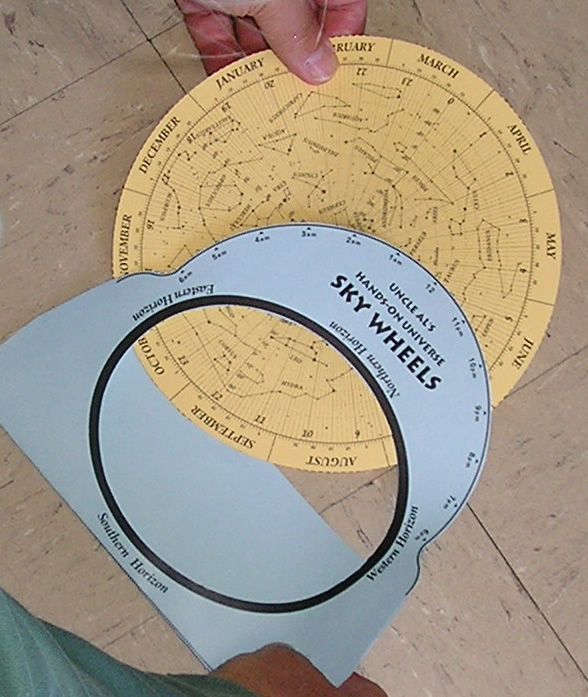AC2.1. Using Star Maps

{ A Changing Cosmos Contents } { Chapter 2 }
Tools for finding things in the sky include: apps, paper maps, and planispheres.
Mobile apps
Two excellent mobile apps for identifying constellations, planets and more:
- Stellarium – for Android, iOS (Apple), and Computer/Laptop
- SkyView – for Android and iOS
Paper maps
Three free paper (PDF) star maps that are good, produced for the current night sky, with new ones available each month are: What’s Out Tonight, Skymaps.com, Beckstrom Observatory.
Planispheres
A planisphere is a version of star map that is adjustable for any day and any time. Standing here on Earth which is rotating, we see everything in the sky wheeling around us once every 24 hours. Each object in the sky appears to move 15° westward every hour as Earth rotates. (15°/hr = 360°/24 hrs) A planetarium is a great place to see such motion speeded up. In a way, a planisphere is like a very rudimentary planetarium. Make a Sky Challenger or Star Wheel to demonstrate this motion.

Sky Challenger
Sky Challengers is a planisphere that has multiple interchangeable star maps with separate maps for Native American Constellations, a Binocular Sky Treasure Hunt, Test Your Eyes-Test the Skies (star magnitudes marked), Where Are the Planets? (ecliptic zone marked), and Invent Your Own Constellations (stars, no constellations). It also includes the first (and only) edition of Stargazers’ Gazette
Although the original version of Sky Challengers is no longer in print, there is a very inexpensive do-it-yourself version of Sky Challenger.
Star Wheels
Star Wheels, also known as Uncle Al’s Starwheels or Sky Wheels, were derived from the original Sky Challenger design.
They were created for the Hands-On Universe project and the NASA Kepler Mission.

Making and Using Star Wheels
You may print a Star Wheel Wheel and Star Wheel Holder from PDFs you may find on the Star Wheels page. Follow the instructions on the printed starwheel sheet, and when it is cut out and assembled, set the Sky Wheel for near the end of the school year, June 1, at shortly after sunset, say 9 p.m.
Notice the Big Dipper is high in the sky and the tip of the handle is near Right Ascension 14 hours, which in turn points close to the word “Southern” in “Southern Horizon” on the Star Wheel Holder. The times on the Star Wheel Holder are always standard time, so you may need to take that into account if your clock is set to daylight savings time.

Rotate the Star Wheel FORWARD 2 hours (to 11 p.m. standard time on June 1).
2.1 What Right Ascension line now points to the word “Southern” in Southern Horizon?
2.2 What constellation just rose, almost due east?
2.3 What constellation is setting in the northwest?
2.4 What constellation is closest to the zenith (highest place in the sky; center of the map)?
Rotate the Star Wheel FORWARD by another 2 hours (to 1 am standard time on June 1).
2.5 What Right Ascension line now points to the word “Southern” in Southern Horizon?
2.6 What constellation is closest to the zenith?
2.7 What constellation is rising, almost due east?
2.8 What constellation is setting in the west?
Rotate the Star Wheel FORWARD another 2 hours (to 3 am standard time, June 1).
2.9 What Right Ascension line now points to the word “Southern” in Southern Horizon?
2.10 What constellation is closest to the zenith?
2.11 What constellation is rising in the northeast?
2.12 What constellation is setting in the northwest?
Notice that there is one star in the sky which does not seem to change its position ever. It’s at the tip of the handle of the Little Dipper, (Ursa Minor) and is called Polaris, or the North Star.
Now some more questions to test your Star Wheel driving skill:
2.13 What constellation is near the zenith on New Year’s Eve at 11 p.m.?
2.14 In what month is the Big Dipper (Ursa Major) highest in the sky at midnight?
2.15 About what time is Leo setting (in the northwest) on the summer solstice (about June 21)?
Earth Rotating on Its Axis and Revolving Around the Sun
Rotating the Star Wheel can represent both rotation (spinning) of Earth and revolution (orbiting) of Earth around the Sun. To imagine Earth’s rotation, keep your attention focused on one date and watch the hours go by that date as you turn the wheel. To imagine Earth revolving around the Sun, keep your attention focused on a particular hour of the night and imagine that you are coming out each night to see that sky at that particular hour of night. You can then watch the days and months go by from the perspective of that particular time of night. The Sun appears to creep Eastward in the sky each day by approximately one degree, or about 30 degrees (2 hours right ascension) per month.
2.16 How many degrees does the sky shift in one month?
Find Messier Objects
Charles Messier, a French comet hunter, created a catalog of interesting sky objects that might look a little like comets, but are not. They are actually a variety of objects including star clusters, galaxies, and nebulae (clouds of gas). If you find a table that has the coordinates of the Messier objects, you can mark them on your own star map. For example, the Owl Nebula is a Planetary Nebula 1630LY from us, whose coordinates are RA 11h14.8m; DEC +55°01′.
As of 2024, the Hands-On Universe Messier Star Wheel is avaialble at https://gss.lawrencehallofscience.org/planispheres/
2.17 In which constellation is the Owl Nebula?
You can download the Messier Catalog Excel File. You might choose to mark the BRIGHTEST Messier objects on your Coordinate Star Wheel, or perhaps the CLOSEST Messier objects.
2.18 Get image(s) of Messier object(s). In book(s) or searching the worldwide web, find Messier objects of the following types: nebulae (gas clouds), globular star clusters, open star clusters, galaxies. Print one for wall decoration or save for a computer screen display.
Moving Planets, Asteroids, and Comets
Most things we see in the solar system—planets, asteroids, and comets—generally move across the sky through the night along with the “fixed” stars. However, most of them very slowly drift relative to stars from west to east as they orbit the Sun. The movements of the planets range from Mercury’s fast orbit motion (as much as 2 degrees per day eastward in the sky) to Pluto’s slow orbit motion (about 1.5 degree per year eastward against the background stars).
You can mark the positions of planets on your Coordinate Star Wheel, but since they change, it’s best if you make those marks in pencil so you can erase and update their positions as needed.
Good ways to find planets include:
- One of the paper star maps listed near the top of this page.
- Get a “planetarium program” that computes celestial coordinates of planets. See http://astro.nineplanets.org/astrosoftware.html
- Que Tal in the Current Sky — http://currentsky.com
- Magazines: Sky & Telescope or Astronomy magazine
- Observer’s Handbook (Royal Astronomical Society of Canada)
- Guy Ottwell’s Astronomical Calendar (Dept. of Physics, Furman University, Greenville, S.C.)
You can also get an ephemeris of the Planet’s Coordinates which is a table of celestial coordinates pinpointing the object’s location at specific time intervals as it moves in the sky. You can find an Ephemeris generator at the NASA Jet Propulsion Lab (JPL) website, https://ssd.jpl.nasa.gov/horizons/app.html#/.
Playlist from NASA’s Skywatching Tips page:
Stargazers’ Gazette
The original Sky Challengers product included the Stargazers’ Gazette, a 4-page document:
- Page 1 (The Night It Rained Stars!)
- Pages 2 & 3 (as two-page spread)
- Page 2
- Page 3
- Page 4
- Sky Jumble (part of page 4)

